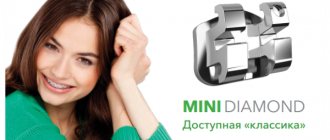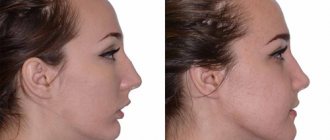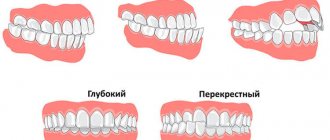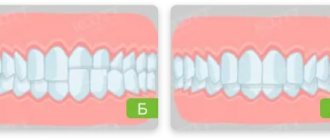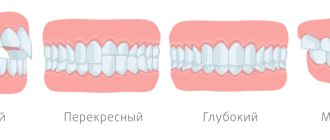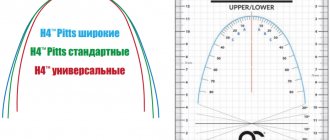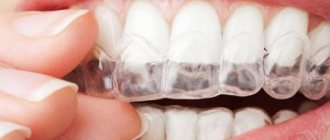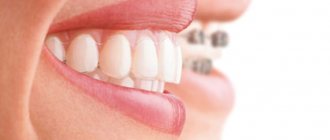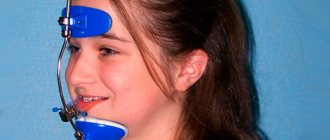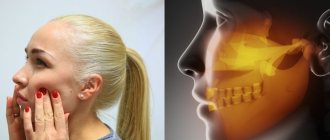For many, a beautiful smile is a dream, since not all of us have naturally perfect teeth. Braces can help correct crooked teeth and malocclusion. Malocclusion is not only an aesthetic problem, so you should not delay orthodontic treatment.
Modern dentistry offers a large selection of systems. Recently, combined braces have become quite popular. They are classic systems that use, in addition to metal structures, ceramic, sapphire or plastic locks. It is this diversity that allows the dentist to choose the optimal treatment option from a financial point of view and the preferences of the patient.
Often, more aesthetically attractive clasps are installed in the smile area, for example, sapphire or ceramic, and metal braces are placed in the chewing teeth area. It is also preferable to install metal structures on the lower teeth, since this area of the teeth is less visible when smiling. Such systems are not only aesthetically superior to conventional metal structures, but many orthodontists also note very high functional performance.
Combined system from a medical and economic point of view
Why do doctors often advise using combined straightener options to correct a bite? It would be much more profitable for them to insist on purchasing more expensive braces - sapphire, for example, (as is what happens in a number of clinics and private offices). However, real specialists in the field will never use additional tricks just to attract more funds to their account or the account of the company for which they work. They will always be based on the wishes of the patient and the real picture of his health.
When an orthodontist suggests a combined type of bite corrector, he is usually guided by the following criteria:
- It is this system that best matches the client’s teeth type, i.e. with its help it is expected to obtain the most effective result and in the shortest possible time;
- combined braces, metal and ceramics or another productive combination will be able to cope with complex curvatures and will look aesthetically attractive;
- This option is convenient for the patient in terms of material expenses.
If we compare various possible combinations and the sapphire system, for example, it is often the braces proposed by the doctor that win, in which ceramic or other devices are used along with metal brackets.
Indications for use
- A compromise between functionality and aesthetics.
In case of significant curvature of the dentition, metal braces are recommended for the most effective treatment, but not everyone is ready to wear them. In this case, you can find a compromise between beauty and benefit by installing different types of systems (according to functional and aesthetic indicators) for the anterior and chewing teeth. - Each jaw has its own braces.
The case when different types of devices are used to correct the bite on different jaws. This is especially true if the lower dentition is more crooked than the upper one, and wearing metal braces is recommended to correct it. And you can safely install a more aesthetic design on your upper teeth. - Financial question.
Metal structures are often recommended for serious anomalies, but bite correction can be successfully corrected using any system. But whether there is enough money for, say, sapphire braces is a big question. In conditions of limited budget, combined systems can serve very well.
Our team of doctors
Maxillofacial surgeon, Implantologist
Bocharov Maxim Viktorovich
Experience: 11 years
Orthopedist, Neuromuscular dentist
Stepanov Andrey Vasilievich
Experience: 22 years
Endodontist, Therapist
Skalet Yana Alexandrovna
Experience: 22 years
Orthopedic dentist
Tsoi Sergey Konstantinovich
Experience: 19 years
Endodontist, Therapist, Orthopedist
Varvyanskaya Anastasia Andreevna
Experience: 6 years
Dentist-orthodontist
Enikeeva Anna Stanislavovna
Experience: 3 years
Ceramic braces
Ceramic braces
For adults, aesthetics is usually more important than for children - they need to appear in public more often and make a good impression. Therefore, ceramic braces are very popular among adults. Their arch is also made of metal, but the clasps are made of special medical ceramics.
Ceramics has a color that is as close as possible to tooth enamel. Thanks to this, braces are much less noticeable on the teeth. The metal arch is still noticeable, but it can be covered with white paint - then if people do not specifically look into your mouth, they will not even notice the braces.
Advantages
- Very high aesthetics.
- Greater hypoallergenicity - ceramics are a more biocompatible material, so they rarely provoke allergies.
- No unpleasant metallic taste in the mouth.
- Less trauma to soft tissues.
Flaws
- Slightly more brittle, which increases the risk of breakage, and also makes it difficult for braces to cope with some serious malocclusions.
- A little more complex care to ensure complete cleaning and maintain aesthetics.
- Some visibility - upon careful inspection, the braces are still visible.
- Difficult to install - such braces are unlikely to be installed in municipal dentistry, and they are not always found in private clinics.
In addition, ceramic braces are slightly more expensive than metal braces, although they are cheaper than many other types of braces. So this is a small drawback, but only relative to metal braces.
In general, if you are looking for a compromise between aesthetics and price, then ceramic braces are the best option.
Combined braces system - types and applications
Today, the variety of different combinations of teeth straighteners is divided into four main groups:
- a system designed to quickly correct malocclusion;
- braces that solve the problem of moderate dental deficiencies;
- braces aimed primarily at eliminating malocclusions of the lower teeth;
- a combined system, which is ordered purely from the point of view of economic benefit.
All of these groups carry their own meaning, but a qualified orthodontist can advise on the most suitable material and brackets, based on several possible options. Next, the choice is up to the patient.
Rules of care
The Damon combined bracket system requires fairly simple care:
- regular cleaning using special brushes and brushes;
- rinsing the mouth with antiseptic agents;
- removing food debris and plaque using irrigators;
- diet correction, exclusion of solid foods;
- regular visits to the dentist at our clinic for treatment correction and monitoring;
- timely treatment of any problem.
Price
The final cost of the Damon bracket system is determined depending on the type of structure used and the defect to be corrected. Based on the diagnostics performed and the calculated treatment plan, it is possible to determine what the price of the correction will be. The full cost will be announced by the doctor after drawing up the treatment plan. It is fixed in the contract and does not change throughout the entire period of treatment at Magenta Dental - from installation of the system to its removal.
The price consists of several components:
- design of the selected type (Clear or Damon Q);
- installation of the device;
- activation and preventive work (you must visit a doctor at least once a month);
- removal of the structure after completion of the main stage of treatment;
- production of retention devices.
To calculate the cost, please make an appointment. Doctors will perform an examination and conduct a number of studies necessary to prescribe a treatment regimen. Based on this, a price will be determined that will not change in the future.
About Us
The Magenta Dental clinic offers installation of the Damon combined brace system. We provide patients with the following benefits of contacting us:
- modern conditions and individual approach to everyone;
- use of certified materials and equipment from leading brands;
- full range of services, including diagnostics;
- guaranteed results and a beautiful smile.
To register, fill out a request on the website using the online form or call by phone. Dental clinic specialists will advise on treatment issues and make an appointment at a convenient time. You can also submit a request by writing to us by email
Quick bite correction is not a fantasy
There is the most attractive system of combined braces from the point of view of significantly reducing treatment time. For many teenagers and young adults, it is the most successful option. After all, any intervention and every device on the teeth is always stressful. Especially when it is not possible to order expensive, invisible braces. Therefore, this option is a brilliant opportunity to correct dental defects quickly and inexpensively. The price of combined braces in this case depends on the material chosen.
As a rule, a combination of ceramics and plastic inserts is selected for such a system. The color can be chosen so that the staples are practically invisible when smiling or talking. Metal will be used only as fasteners or for the most problematic areas.
Unpleasant moments after installation
Despite all the advantages of such braces, they, like all other orthodontic structures, involve some unpleasant moments after installation.
Almost everyone who has ever been interested in the possibility of getting straight teeth knows about this today. During the consultation, the doctor will once again remind the patient about possible inconveniences during bite correction. Almost everyone experiences discomfort in the first days and weeks after installation. This is due to the unusual constant load and pressure on the teeth that braces exert. Therefore, there is no need to be afraid of an unpleasant moment: the discomfort will pass on its own.
There is also a risk of inflammation of the mucous membrane upon contact with braces and friction, but this can also be solved. Problems with diction are also easy to fix. In general, after a month, all patients get used to braces and stop noticing them.
If you save, then only through combined systems
Not all clients have the same ability to pay, but everyone wants to look beautiful. In this case, a transparent material or one that blends with the enamel is selected for the front part of the upper and lower jaw, and ordinary metal brackets are used for the hidden areas of the teeth; two goals are pursued at once:
- cost savings;
- aesthetic appeal.
Such combined braces look simply wonderful in the photo, just as they do in real life. In addition to their main purpose, therapeutic, they also reduce the negative impact on the patient’s psyche. Because they look quite decent.
Advantages
The advantages of combined Damon Clear and Damon Q braces include:
- high rates of correction efficiency;
- high aesthetics;
- food coloring resistant, no pigmentation or darkening;
- low coefficient of friction between tooth enamel and structural elements;
- precise fixation, treatment control;
- patented fastening of individual components of the Spin Tek device;
- made from medical steel, durable and corrosion-resistant;
- there is no aftertaste, diction or speech problems when worn;
- The correction procedure is simple and does not take much time;
- soft tissues and enamel are not injured when worn;
- alignment of the row occurs naturally;
- uniform load distribution.
Prices for combined braces
The approximate price for installing a brace system is indicated in the price list, but for more information, please contact the clinic.
Consultation with an orthodontist
- X-ray panoramic image
- Oral examination
- Drawing up a treatment plan with costs
Price: 0 ₽
| Correction of bite with braces (1 jaw) | from 150,000 ₽ |
| Correction of bite with lingual (invisible) braces (1 jaw) | from 200,000 ₽ |
| Correction of bite with mouth guards (1 jaw) | from 300,000 ₽ |
Author:
Features of caring for combined braces
Anyone who decides to get braces should be prepared for regular visits to the orthodontist and review their habits and diet. Any braces system, including combined ones, requires strict adherence to hygiene rules. To care for your oral cavity during orthodontic treatment you will need:
- toothbrush (orthodontic, mono-beam);
- dental floss (orthodontic);
- brushes for interdental spaces;
- special toothpaste and mouthwash;
- remineralizing gel;
- Oral irrigator.
At first, the process of brushing your teeth will not be quick, but after getting used to it, no difficulties should arise during hygiene procedures. It is necessary to brush your teeth after every meal and it is recommended to do this for at least 5 - 7 minutes.
With combined systems, it is especially important to monitor the products you consume, because both durable metal braces and more fragile ceramic ones are installed. Unsuitable food can get stuck in the structure and cause the braces to warp or come off. The difficulty is that if the ceramic elements come off, they cannot be reinstalled; you will have to order new ones. In addition, some foods can stain the ceramic and its aesthetic properties will deteriorate. It is necessary to exclude:
- hard, crunchy and sticky foods (such as nuts, crackers, chewing gum, toffee);
- coffee, brightly colored drinks, etc.;
- smoking.
Alternatives to braces treatment
Modern braces may be aesthetically pleasing, but they are still noticeable or not very comfortable - they impose many dietary restrictions, complicate oral hygiene, and damage soft tissues and enamel. Therefore, it is logical that you want to correct your bite without braces.
In adulthood, there are only two such methods.
Removable mouthguards
Special mouthguards made of transparent plastic. They are made individually from impressions and put pressure on the teeth in much the same way as the arch of braces. Mouthguards should be removed when eating or brushing teeth, and they do not have to be worn all day, for example, during public speaking. At the same time, the aligners themselves are also transparent and invisible - judging by the reviews, they are even less visible than ceramic or sapphire braces.
In general, mouthguards are much more convenient than braces, but they are only suitable for minor malocclusions, and are also expensive, about the same as lingual braces.
Veneers
Veneers are special ceramic shells that cover teeth. They are used if the front teeth are slightly crooked, but the anomaly is not serious, and you don’t want to get braces for it. Onlays can mask minor irregularities and gaps between the teeth, that is, they do not actually correct the bite, but make the smile perfect.
Alternative methods are more convenient, but for severe malocclusions, braces are still the only effective treatment.
Indications and contraindications
It is advisable to install combined braces in the following cases:
- Individual teeth need to be adjusted. For example, one dental unit needs to be moved over a long distance.
- The patient wants to save money by placing ceramics or sapphires on the front teeth, and metal elements on the chewing teeth.
Contraindications:
- allergic reaction to the material of the product;
- oncology;
- tuberculosis;
- the presence of caries and gum disease;
- immunodeficiency states;
- mental disorders;
- lack of supporting teeth.
How to install braces for adults
The installation of braces follows the same scheme, regardless of the chosen system. It all starts with preparation, which takes place in several stages:
- The dentist talks with the patient, examines his teeth, and listens to his expectations from treatment.
- X-rays, computed tomography are done, and if necessary, an impression is taken. Based on this, the treatment is simulated on a computer.
- A decision is made on the material of braces based on the examination and the wishes of the patient.
- Sanitation of the oral cavity is carried out - all diseases of the gums and teeth are treated, so that in the future there will be no need to carry out treatment and remove braces for this. Professional cleaning is also required.
- If it is necessary to create free space in the jaw, individual teeth are removed - usually chewing molars.
After the teeth are completely prepared, the braces are installed directly. It goes according to the following scheme:
- The teeth are thoroughly cleaned of plaque and dried of saliva.
- The enamel is etched with a special acid. It is safe, but makes the enamel more susceptible to the adhesive.
- A small amount of adhesive glue is applied to the enamel. Some modern braces have an adhesive on the clasps themselves - in this case this step is skipped.
- Braces are attached to the teeth one at a time.
- Excess adhesive is removed so as not to create voids under the braces, and then hardens under the influence of a special lamp.
- An archwire is threaded into the braces.
At this point, the installation is considered complete, the patient is taught how to care for braces, the next follow-up appointment is scheduled, and he is sent home. The whole process takes about half an hour; in the case of lingual braces, it can take an hour.
After installation, the patient will need to visit the doctor several more times to monitor the correction of the bite and replace the arch with a less flexible one.
Options
There are several ways to combine components of bracket systems. The most commonly used options are:
- Combination of vestibular and lingual systems. Since the upper row of teeth is more visible during communication, dentists suggest installing a lingual appliance on it. The lower jaw row can be equipped with a low-cost vestibular system.
- Different materials for jaw rows. In situations where one of the teeth is more crooked than the other, dentists recommend the following treatment option.
Strong metal braces are installed on teeth that require more tension. Plastic or sapphire plates are attached to the second jaw, usually the upper jaw, which look more aesthetically pleasing and do not cause excessive pressure. - Combination of materials in one design. In the jaw row, varying degrees of curvature of the teeth can be observed, the correction of which requires different loads.
For this purpose, a system is manufactured in which several materials are combined. Most often, sapphire plates are fixed on the incisors included in the smile zone, and metal braces are fixed on the remaining units.This approach to treatment guarantees not only high efficiency, but also an aesthetic appearance of the oral cavity.
- Reinforcement of the structure with metal. To reduce the duration of treatment, conventional plastic or ceramic braces can be further strengthened.
For this purpose, the grooves in which the power arc is fixed are reinforced with special medical steel. The aesthetics of the entire structure are somewhat reduced, but the effectiveness and speed of therapy increase.
The use of a specific combined design depends not only on the wishes of the patient, but also on the complexity and degree of neglect of the occlusion pathology.
How the system works
The operation of the bracket system is based on the principle of passive ligation. The device is a ligature-free design, in which a locking flap is used instead of conventional fastenings. By holding the arc in the grooves, the clamp does not block its operation, maintaining the possibility of dynamic movement and reducing the friction factor. The technique ensures the work of the facial muscles and softens the process of adjusting the bite.
The choice of a corrective device is based on the recommendation of the attending physician, received after a comprehensive examination, which allows one to draw up a clinical picture. Among the advantages that the most popular models of the line have - combined braces Damon Clear and Damon Q, dentists note:
- softness and smooth movement of teeth, reducing the likelihood of applying mechanical herbs in the gum area;
- convenience, aesthetics and safety of the locking mechanism;
- small dimensions and ease of maintenance;
- use of specially designed arc elements for correction;
- Possibility of quickly replacing archwires using Spin Tek clamps.
Straight teeth are the main goal of installing braces. The presented options are suitable for both adults and children. Due to the length of the recovery procedure, the optimal solution is to use combined systems to minimize physical and psychological discomfort.
Nutrition during braces treatment
To prevent your braces from breaking during treatment and your teeth from getting sick, you need to eat right:
- Avoid any sticky or chewy food - chewing gum, toffee, nougat and caramel. All of these products can easily get stuck in the braces, move them, and break the entire system, which will disrupt the treatment process.
- Do not bite too hard foods: apples, carrots, crackers, nuts. Even a single bite can change the tension of the wires or lead to breakage of the bracket. Such products are not completely prohibited, but they need to be crushed.
- Do not eat hot food immediately after cold food and vice versa. Such sudden temperature changes not only damage the enamel, but can also cause the braces to strip, stretch and narrow its individual components.
- Try not to use products with dyes - they can change the color of the ceramic or sapphire braces.
- Limit carbohydrates—while wearing braces, they are difficult to clean completely and can cause tooth decay. This is especially true for sweets.
Classification
For corrective therapy, different types of devices are used, distinguished by the following parameters:
- manufacturing materials;
- place, features of fixation;
- type of arc fastening;
- complexity of the design.
Most often, metal elements are used for the lower row and chewing zone, and transparent sapphire or ceramic for the front. According to the type of fastening of the bracket and arch, two types are distinguished:
- non-ligature, most convenient for the patient;
- ligature, with special elastic bands.
Based on the type of fixation to enamel, systems are divided into the following types:
- using glue (the most gentle option);
- indirect fastening with locks.
Adhesive fixation is inexpensive and fast, but requires a certain amount of experience from the doctor. Indirect is more effective and indicated for eliminating complex disorders. In some cases, lingual installation is recommended, that is, the structure is placed on the inside of the row, and not on the outside, as for the vestibular one.
Terms of wearing. Efficiency
The experience of dentists shows that the duration of the process of correcting a bite using combined braces depends on the complexity of the initial situation.
Most often, it takes from 6 to 12 months to completely restore the correct position of all elements of the row. In case of complex occlusion pathologies, this process can take up to one and a half to two years, since the movement of molars occurs quite slowly.
Patients note that the first time after installing braces, inflammation of the oral mucosa, redness and bleeding of the gums may be observed.
In some cases, tooth pain occurs as a result of pressure on them. When installing a lingual system, diction may be impaired.
